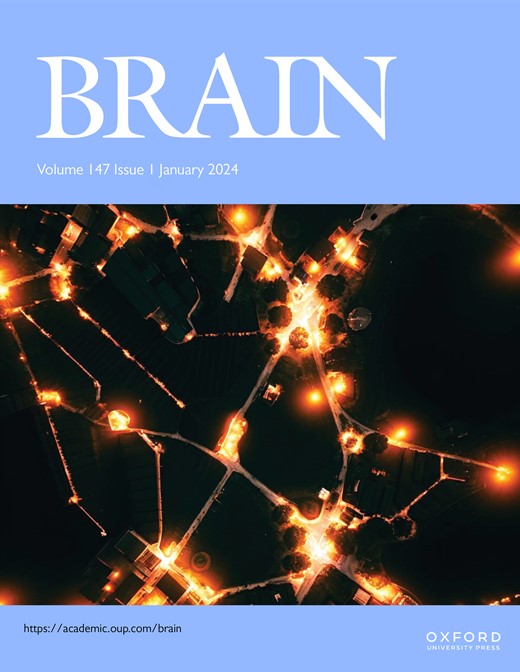Engineered neural stem cell vesicles activating Wnt promote blood-brain barrier repair after cerebral haemorrhage.
IF 11.7
1区 医学
Q1 CLINICAL NEUROLOGY
引用次数: 0
Abstract
The blood-brain barrier (BBB), a highly specialized neurovascular structure indispensable for preserving cerebral homeostasis, exhibits significant impairment across diverse neurological pathologies; however, its therapeutic targeting persists as a formidable challenge due to the inherent complexity of its multicellular architecture and dynamic regulatory networks. Although the Wnt/β-catenin signaling pathway orchestrates the development and maintenance of the BBB, the clinical translation of Wnt-based interventions remains elusive. We fabricated functionalized extracellular vesicles derived from neural stem cells (EVs-WK) by loading them with an engineered BBB-tropic ligand, Wnt7a-K190A, using electroporation. The therapeutic benefits of EVs-WK for BBB protection and repair were subsequently interrogated through comprehensive in vitro and in vivo analyses. In vitro mechanistic studies demonstrated that EVs-WK had three main effects: they enhanced BBB integrity, promoted synaptogenesis through β-catenin-mediated reinforcement, and significantly attenuated neurotoxic activation of astrocytes. Cross-species validation using humanized EVs (hEVs-WK) confirmed the conserved therapeutic efficacy of this approach, as shown by the mitigation of LPS-induced barrier dysfunction and downregulation of inflammatory pathways. In murine intracerebral hemorrhage (ICH) models, administering EVs-WK significantly reduced hematoma expansion and accelerated motor recovery. This modular EV platform combines BBB restoration with neurovascular unit repair, thus overcoming critical translational barriers in neurological therapeutics through targeted-controlled activation of Wnt signaling.激活Wnt的工程神经干细胞囊泡促进脑出血后血脑屏障修复。
血脑屏障(BBB)是一种高度特化的神经血管结构,对维持大脑稳态至关重要,在多种神经病理学中表现出显著的损伤;然而,由于其多细胞结构和动态调控网络的固有复杂性,其治疗靶向仍然是一个艰巨的挑战。尽管Wnt/β-catenin信号通路协调血脑屏障的发展和维持,但基于Wnt的干预措施的临床翻译仍然难以捉摸。我们利用电穿孔技术在神经干细胞(ev - wk)上装载一种工程的BBB-tropic配体Wnt7a-K190A,制备了功能化的细胞外囊泡。EVs-WK对血脑屏障保护和修复的治疗益处随后通过全面的体外和体内分析进行了探讨。体外机制研究表明,ev - wk具有三个主要作用:增强血脑屏障完整性,通过β-catenin介导的强化促进突触发生,并显著减轻星形胶质细胞的神经毒性激活。利用人源化EVs (hEVs-WK)进行的跨物种验证证实了这种方法的保守治疗效果,如lps诱导的屏障功能障碍的缓解和炎症通路的下调所示。在小鼠脑出血(ICH)模型中,给予ev - wk可显著减少血肿扩张并加速运动恢复。这种模块化的EV平台将血脑屏障修复与神经血管单元修复相结合,从而通过靶向控制Wnt信号的激活来克服神经治疗中的关键翻译障碍。
本文章由计算机程序翻译,如有差异,请以英文原文为准。
求助全文
约1分钟内获得全文
求助全文
来源期刊

Brain
医学-临床神经学
CiteScore
20.30
自引率
4.10%
发文量
458
审稿时长
3-6 weeks
期刊介绍:
Brain, a journal focused on clinical neurology and translational neuroscience, has been publishing landmark papers since 1878. The journal aims to expand its scope by including studies that shed light on disease mechanisms and conducting innovative clinical trials for brain disorders. With a wide range of topics covered, the Editorial Board represents the international readership and diverse coverage of the journal. Accepted articles are promptly posted online, typically within a few weeks of acceptance. As of 2022, Brain holds an impressive impact factor of 14.5, according to the Journal Citation Reports.
 求助内容:
求助内容: 应助结果提醒方式:
应助结果提醒方式:


